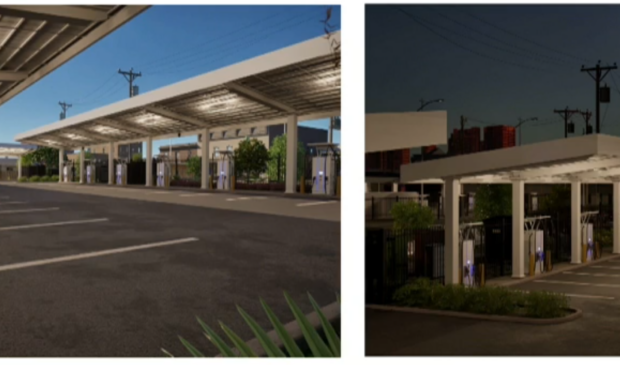Commercial EV station moves forward despite opposition
Wednesday, February 19, 2025 by
Madeline de Figueiredo After the Planning Commission denied the request for a commercial electric-vehicle charging lot in East Austin last April, the project is moving forward based on an ordinance passed by City Council.
Last April, the Planning Commission voted 7-3-3 to deny the request for the commercial fleet EV charging station that would not be open to the public. The commissioners expressed concern that the proposed use of the site, located at the intersection of Pleasant Valley Road at Cesar Chavez Street, was not aligned with the Imagine Austin corridor priorities of walkability.
“I just really don’t feel like this decidedly auto-oriented use is appropriate in this area that we’ve identified for walkability and pedestrian-oriented uses in our comprehensive plan,” Commissioner Alice Woods said at the April meeting.
Commissioner Felicity Maxwell also pointed out in the meeting that the city is building a new pedestrian and bike bridge just a few blocks to the south, which will enhance multimodal options in the neighborhood.
The original request was for an off-street parking lot, which is a conditional use requiring commission approval per the Neighborhood Plan. Voltera Power, the property owner, appealed the Planning Commission’s April decision denying their request, but later withdrew the appeal.
In May, City Council passed a new zoning ordinance for EV charging stations that offered a new pathway forward for Voltera. Under the new ordinance, the company, which operates similar operations nationwide, can proceed with the EV charging use, but it is subject to certain restrictions for conditional use approval.
Michael Phalan, a Holly resident living near the property, said that while certain sections of the Neighborhood Plan could limit this use, they haven’t been updated, meaning city planning staff must interpret which rules apply. As a result, the site plan moved forward without needing further review by either the Planning or ZAP commission.
“This ordinance passed in May and then within a couple of months this huge operation is using this ordinance to circumvent the Planning Commission’s decision,” Phalan said to the Austin Monitor. “But the neighborhood doesn’t have an opportunity to amend their Neighborhood Plan.”
“So even if the neighborhood saw a new use spelled out in the city’s ordinances, there’s no ability for the neighborhood to quickly say that new use should be categorized as a conditional use,” Phalan said.
In a May City Council meeting, then-Council Member Alison Alter noted that the approval of this ordinance would help develop the infrastructure for the anticipated number of EVs. She said that these charging stations would likely not serve average drivers, but “ride-shares, fleets, other folks who are really trying to transition their vehicles to EVs to help with our environment.”
As of mid-February, the permit for Voltera’s project had been approved.
A statement from the company to the Monitor focuses on sustainability goals: “Over the past two years, our team has engaged with Council Members, Planning Commissioners, City staff, neighbors, and other stakeholders to ensure the project meets all standards required in Ordinance 20240516-007,” said Tom Ashley, Voltera’s vice president of government and utility relations. “We are committed to being a good neighbor and are excited to help the City achieve its transportation electrification goals and contribute to a cleaner, more sustainable Austin.”
Phalan warned that these gaps in the ordinance could open the door to large-scale charging stations without offering neighborhoods the adequate latitude to review and respond in a timely manner.
“The neighborhood plan doesn’t have a chance to catch up in this case,” Phalan said. “This ordinance offers companies a path forward and leaves communities behind.”
Project rendering by Voltera via the Planning Commission.
The Austin Monitor’s work is made possible by donations from the community. Though our reporting covers donors from time to time, we are careful to keep business and editorial efforts separate while maintaining transparency. A complete list of donors is available here, and our code of ethics is explained here.
You're a community leader
And we’re honored you look to us for serious, in-depth news. You know a strong community needs local and dedicated watchdog reporting. We’re here for you and that won’t change. Now will you take the powerful next step and support our nonprofit news organization?






